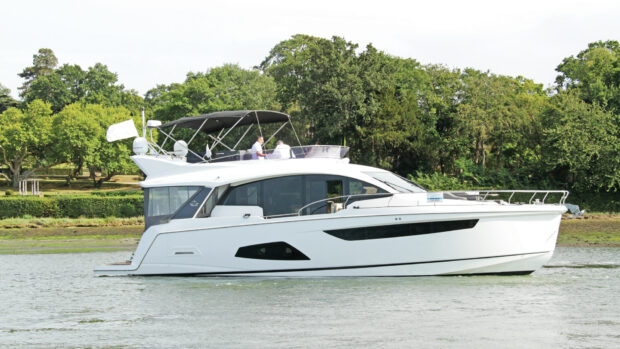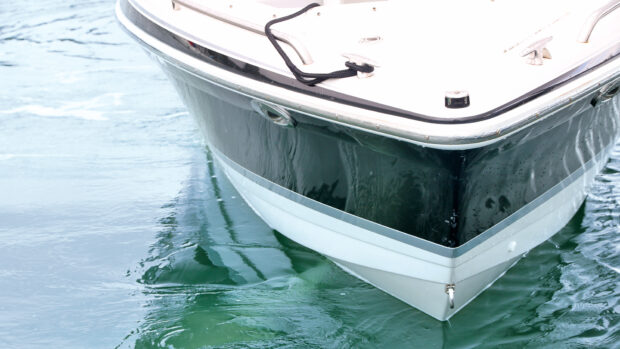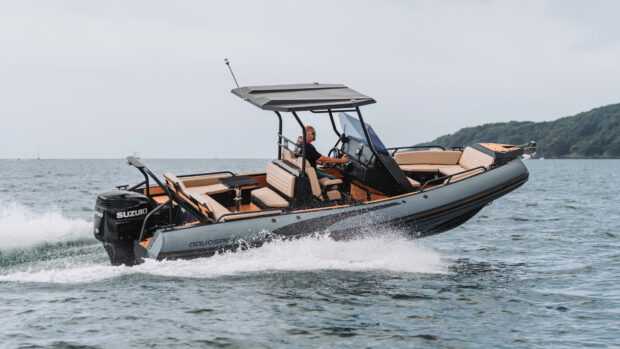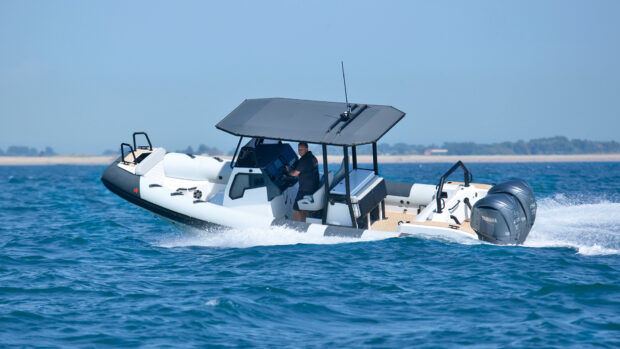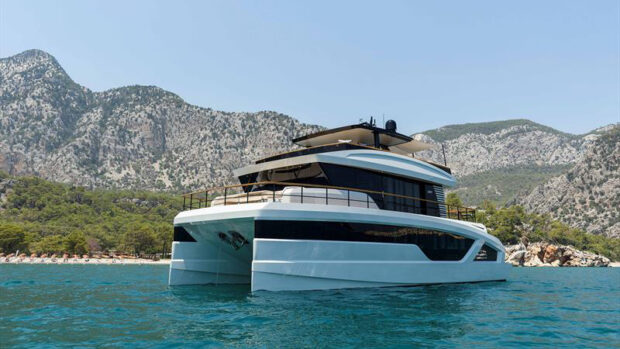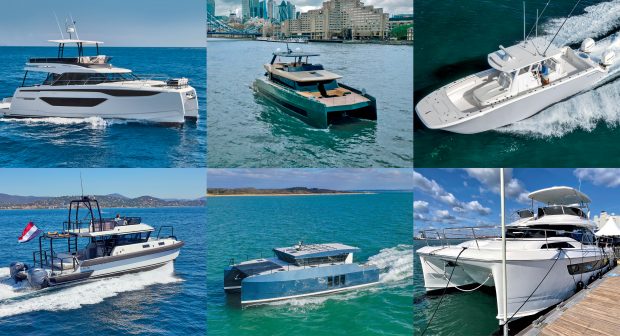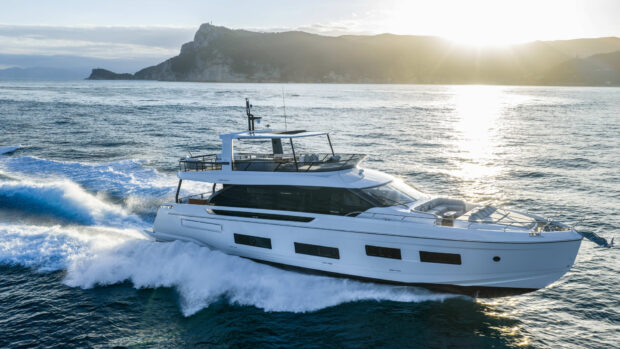Sirena’s entry-level cruiser is now available as a hybrid-powered coupé but is the Sirena 48 Coupé as good as the flybridge and do the sums add up?
When Turkish yard, Sirena Marine, introduced the new Sirena 48 at the entry point to its award-winning fleet of liveaboard cruisers, the idea was to transfer the brand’s traditional big-boat versatility into a more youthful and accessible package. It worked too. With its voluminous hull and upright superstructure, it delivered a claimed 25% more usable volume than its competitors and it did so while finessing the classical bulk of the trawler yacht with elegant features. So where, you might ask, is the merit in the Sirena 48 Coupé a chopped down version of that same boat?
Well the simple fact of the matter is that some people don’t like flybridges. They don’t like the style of them, they don’t like the windage, they don’t like the elevated weight and they don’t care for the ongoing maintenance.
Some baulk at the implicit ostentation of a raised sundeck too, particularly if they boat in northern Europe where tastes are modest and the weather is cold. And some favour a brighter, more open saloon than a flybridge cruiser is able to provide.
So there we have it: the Sirena 48 Coupé – and in this case, not just a Coupé but a Coupé Hybrid. Because if you’re going for a more modern, dynamic and lightfooted approach, why not replace the twin diesels with at least the option of a serial hybrid drivetrain?
As you would expect, the Sirena 48 Coupé main deck layout is identical to that of the established flybridge model, save for a couple of basic differences. Firstly, there’s some extended cabinetry on the starboard side of the saloon, where the flybridge steps would otherwise go, enabling the inclusion of a full-height fridge freezer.

The semi-displacement hull gives a comfy cruise at any speed
And secondly, there’s a rather lovely new roof structure, which features a subtle curve, as well as a useful flare that sees it jut out above the side decks in exactly the same fashion as the fly model. Better still, while this roof space has been well used for a large solar array, it still enables natural light to flood through the central panels, creating some lovely patterned sunlight in the saloon space. In tandem with the large vertical windows, the low-level dash and the linear, fuss-free furniture, that lends this saloon an even more striking sense of openness than the original 48.
Article continues below…

Can the new entry-level Sirena 48 repeat the success of its bigger sister?

Best hybrid diesel electric boats: The best of both worlds?
The layout itself is also very easy to get on with. The two-person helm gets direct access to the starboard side deck through a big skipper’s door, and opposite that, a convertible C-shaped dinette gets great views thanks to the raised deck level in the forward part of the saloon and a large portside window. It does position you a little way aft of the skipper so sociability on passage could be better.
The L-shaped galley, on the other hand, enjoys a very natural union with the aft cockpit thanks to a three-part sliding door and an opening window above the bar. It’s well proportioned too, with an oven, a sink, a dishwasher and plenty of high-level storage, plus another sliding window directly above the four-ring electric hob.

Six knots provides up to 30 silent miles on the batteries alone
And as for the cockpit itself, you can arrange that in all kinds of ways, with everything from a pair of facing settees to a forward-facing transom bench. As on the flybridge model, there’s extra flexibility dialled in here too, enabling you to opt for a waterside lounge on the swim platform or a transverse crew cabin.
As you move along the side decks, sheltered beneath those flared overhead mouldings, it quickly becomes clear that the foredeck lounge is also very generous for a boat of this length. Even with three people loaded full-length onto the long island sunbed, there’s still plenty of space for a forward-facing three-man bench at its leading edge, plus a sensible, workmanlike forepeak, with beautifully integrated cleats and fairleads.
Given the sunbed’s extraordinary length, you would think the designers must have been tempted to shorten it up and integrate a facing lounge in the forepeak instead. But as illustrated by the twin steps that take you up to the raised bow, cabin volume remains a major part of what makes the entry-level Sirena 48 so attractive.

The raised foredeck and vertical hull sides create lots of space in the ensuite bow cabin
When you head down the steps to port of the helm, the first thing you see, beyond the bright central atrium, is the VIP cabin in the bow – and as the foredeck furniture suggests, volume is outstanding. With that beam-forward design and those near-vertical hull sides, you get a large taper-free central bed with plenty of space on both sides.
While there are no hatches or skylights in here, you do get decent hull windows and opening portholes and you also get plenty of cruise-friendly storage options, plus a really impressive port ensuite that also functions as the day heads. There’s a good size of shower compartment in here with a huge flush-mounted rain shower and again, Sirena has factored in a really thoughtful mix of drawers, shelves and storage compartments.

The heads in the bow cabin
Across the companionway to starboard, a deep-set twin cabin provides full-height hanging storage at the foot of the bed plus an astonishing 8ft of headroom beneath the helm for changing your clothes. And yet, as on the flybridge model, it’s the full-beam owner’s cabin that really hits the mark.
On the starboard side is a chaise longue-style settee beneath a large hull window, plus a dressing table that butts up against the forward bulkhead with a mirrored flush-mount TV above it. On the port side is a long integrated storage cabinet and in the centre, a large fore-and-aft bed gets plenty of vertical height for propping yourself up as well as excellent views through the big windows. The ensuite bathroom is pretty impressive too. It occupies the space behind the aft bulkhead for the day heads, which it broadly mirrors both in terms of footprint and fit-out and that’s a very good thing.

Headroom in the starboard twin is truly outstanding
Now of course, such is the volume on this lower deck that Sirena’s designers could probably have factored in four cabins if necessary, but with the three-cabin arrangement you see on the test boat, everything feels really easy and unforced, particularly as the deck levels do such a good job of mitigating any regions where the deckhead dips. And it feels cruise-friendly too – partly because of the space, partly because of the storage, and partly because of neat little features like the washer-drier, which is tucked neatly out of sight in a dedicated cabinet at the entry point to the owner’s cabin.

The V-shaped forward bulkhead creates the space for a pair of doors in the shared bathroom
Propulsive preferences
The new 48’s serial hybrid powertrain sees the Sirena’s semi-displacement hull partnered with a pair of 213kW E-Motion electric motors. Those are hooked up to twin 39kWh battery banks, which are fed by a pair of E-Motion variable speed 180kW generators, supplemented by additional input from the 4.2kWh solar array that lines the roof of the coupé structure.
You can double the battery capacity from 78kWh to 156kWh and that will of course bring extra running time, but the basic principle behind this boat is that, if you cruise at the quoted optimum speed of about 6.5 knots, you can run for 1.8 hours (12 miles) on the standard battery pack or 3.6 hours (24 miles) on the uprated supply before you need to top up with your generators.

There’s some neatly concealed refrigeration where the flybridge steps would otherwise go
You can also increase that range to 15 and 30 miles respectively if you drop the pace to 5.7 knots and, as you would expect, recharging takes no guesswork on your part because once the battery level reaches 20%, the generators automatically kick in, bringing you back to 90% in as little as 45 minutes.
The fact that the diesel tanks contain exactly the same amount of fuel (1,900L) as the diesel-powered flybridge model means that overall range is also strong. Sirena quotes a mixed-use (diesel and electric) cruising range of around 350Nm. That falls significantly short of our own calculations but you can of course increase the range by dropping the pace. And yet in spite of Sirena’s talk of 35% fuel savings, this boat doesn’t seem substantially more efficient than the twin Cummins 550s of the flybridge variant we tested back in 2024.

The roof-mounted solar array creates a pleasant checkerboard light pattern in the saloon
Even on that first model, which was a couple of tonnes overweight, we were seeing broadly comparable range figures – and substantially higher ones at low speeds. So in truth, it seems more accurate to say that this new boat simply opts to burn its 1,900L of diesel in a different way.
Now that probably sounds like a criticism but of course the reality is much more textured than that. Yes, the hybrid system pegs you back to 14 knots rather than the 27 the conventional platform delivers so it makes good sense that those who favour internal combustion can continue to buy this Coupé model with Cummins 550s or Volvo D11-670s.
But this hybrid system also enables you to make a low-profile departure from the harbour or creep into a secluded bay without upsetting the locals with noise or emissions. It enables you to pootle about at low speeds without filling the aft cockpit with fumes.

You can slide silently into a remote bay without upsetting the locals
If you top up the banks before bed, you can also enjoy eight hours’ sleep without running generators, even with your AC and AV systems on. And the fact that it promises to cut your maintenance costs by 10-15% doesn’t hurt either.
Sirena 48 specifications
LOA: 52ft 8in (16.04m)
BEAM: 16ft 5in (5.00m)
DRAFT: 3ft 10in (1.16m)
DISPLACEMENT: 28,600kg (light)
FUEL CAPACITY: 1,900 litres
WATER CAPACITY: 600 litres
ENGINES: twin 213kW E-Motion motors
RCD: B16
CONTACT: sirenayachts.com
Sirena 48 costs and options
€1.5M ex VAT
Test boat includes the following options…
Hybrid propulsion system
 If you enjoyed this….
If you enjoyed this….
Motor Boat & Yachting is the world’s leading magazine for Motoryacht enthusiasts. Every month we have inspirational adventures and practical features to help you realise your sailing dreams, as well as tests and news of all the latest motorboats.
Plus you’ll get our quarterly Custom Yachting supplement where we share the last on offer in the superyacht world and at the luxury end of the market.
Build your knowledge with a subscription delivered to your door. See our latest offers and save at least 30% off the cover price.
Verdict
When you chop off a flybridge, you want to know that the weight distribution, the style and the saloon ambience will all be direct and immediate beneficiaries – and that is absolutely the case here. This is a very pretty and well conceived coupé that retains all of the flybridge’s merits, flexibilities and options with the sole exception of the upper deck itself. Little wonder then that Sirena is set to make the Coupé variant an option on some of its larger models, including the 58, 68, 78 and 88. As for the hybrid powertrain, well that’s more likely to split opinion. On the one hand, it makes quiet, emissions-free operation an immediate and very straightforward reality for mixed use boaters. On the other, it all but halves your top end without substantially extending your low-speed operating range. But it’s not for us to baulk at the luxury of choice. Because while once, there was only a single option at the entry point to Sirena’s award-winning fleet of liveaboard cruisers, now there are three – and what’s not to like about that?




 If you enjoyed this….
If you enjoyed this….